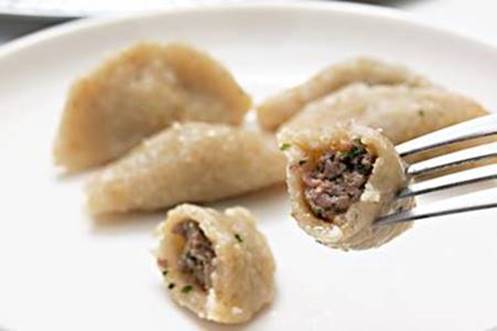“Kbeibat dough is usually made with a combination of bulgur and farina/semolina. My aunt Masy soaks, strains, and purées bulgur in a food processor, and then kneads in some farina and water. The filling is made with ground beef, spices (in my family’s case, just some black pepper), onion, and parsley. Some cooks fill their kbeibat with raw meat and some fill theirs with sautéed meat — there are pros and cons of each method, and each result is totally different. The sautéed filling has that seared-meat flavor, which nicely contrasts with the subtle flavor of the boiled dough. On the other hand, the raw filling gently cooks along with the dough, and result in a more satisfying texture. To see an example of semolina kbeibat, made with the raw filling method, check out my friend Tony Tahhan’s kbeibat.
Either way, you can’t go wrong,” says Kathryn Pauline, the food writer, photographer, and recipe developer behind the Saveur award-winning food blog, Cardamom and Tea.
Antonio Tahhan is a Syrian-Venezuelan American food writer, researcher, and blogger who moved to Florida with his family when he was younger. He pursued degrees in Math, Economics, and Spanish Literature at Cornell University. He studied food anthropology and became fascinated by its stories, traditions, and taboos. In 2010, he was awarded a Fulbright Research Grant to go to Syria, where he studied the midday meal in three contexts: at homes, in restaurants, and in the streets. From cooking to eating, food was a natural vehicle for cultural exchange and one that Antonio continues to explore.
“I enjoy making Middle Eastern dumplings called kbeibat, Assyrian-style semolina-bulgur dumplings stuffed with a spiced lamb kofta filling. The first time I made them without my Syrian grandmother, she was there the entire time, over the telephone, walking me through each step,” he says.
Antonio documents recipes and stories from Aleppo and his many travels, bringing people together online and in person around the love of food. During the recent pandemic, he even launched a web series called “Teta Thursdays,” a virtual conversation on food, culture, and identity. Each week, he interviewed food writers and researchers who specialize in the food culture of the Arab world. He was accepted to the Master of Arts in Arab Studies program at Georgetown University where he plans to attend this fall. “The dough for these dumplings is basic: bulgur, semolina and water. My first attempt at making the dough was a complete disaster. According to my grandmother, I over-soaked the bulgur and added more water than I needed.”

The dough starts with the bulgur:










